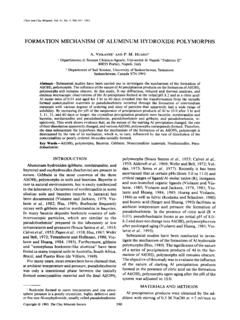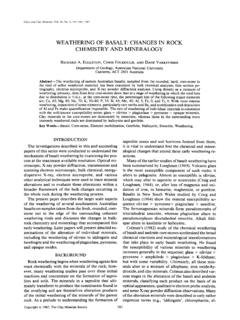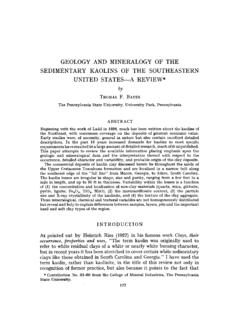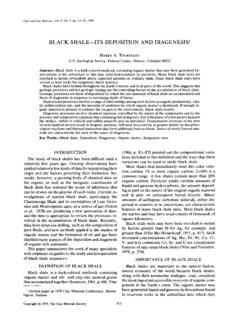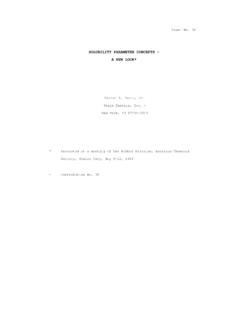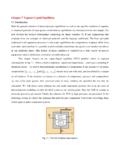Transcription of BOOK REVIEWS - The Clay Minerals Society
1 Clays and Clay Minerals , Vol. 28, No. 4, 319, 1980. book REVIEWS Chemical Equilibria in Soils, by Willard L. Lindsay. Wiley-Interscience, New York, 1979. 449 pp., Cloth, $ This book by a veteran teacher and graduate research di- rector in soil chemistry at Colorado State University seeks to utilize the equilibrium thermodynamics of heterogeneous aqueous systems for understanding and predicting the chem- ical reactions that take place in soils at 25~ and 1 atm. Fol- lowing 28 pages of introduction and definition of chemical principles, are chapters on chemical substances of importance in normal soils (A1, SIO2, aluminosilicates, Ca, Mg, Na and K, Fe, Mn, phosphates, Zn, Cu, N, S, Mo) and harmful metals (Ag, Pb, Cd, Hg), as well as several on processes (organic transformations, chelate equilibria, carbonate equilibria). Problems involving both discussion and numerical calculation are presented after each chapter.
2 An appendix of selected standard free energies of formation compiled by Muhammad Sadiq and the author is included. Readers are put in touch with a sizeable number of publi- cations in soil chemistry, physical chemistry, and geochem- istry, including many from the 1970s. The redirection of the basic Eh-pH relationships toward the particular chemical sys- tems and processes of concern to soil chemists should result in these concepts being assimilated much more readily by the students and professionals in this field. There are many worked examples, albeit at a very simple level. Measured against the competition, , Garrels and Christ's Solutions, Minerals and Equilibria or Stumm and Morgan's Aquatic Chemistry, Chemical Equilibria in Soils is a truncated and frequently unsubtle book . Although one chap- ter is devoted to chelation, and complex-ion equilibria are dis- cussed in several chapters, nothing is included about adsorp- tion equilibria.
3 The author relies very heavily on a single type of diagram that displays solubilities of several substances against another variable, such as pH, so that at a particular pH one can identify the thermodynamically stable substance as the one with the lowest solubility. The quantity pe appears as the variable on an axis of four diagrams; elsewhere, the hybrid parameter, pe + pH, whose usefulness still escapes this re- viewer after an admittedly brief exposure, is used where redox reactions are involved. Proton activity and electron activity are still hard to beat as plotting variables for such systems. If the reader wants to know why a particular free energy value listed in the appendix is deemed the best value, or how it was calculated, he must obtain Colorado State University Experiment Station TechnicalBulletin 134, by Sadiq and Lind- say (1979). This bulletin is apparently thick and expensive, and Colorado State, understandably, does not include it in its usual publication exchanges.
4 It must be ordered separately which may explain why my university library does not own a copy. There is great variation in the extent to which principles are explained. Problem on page 31 asks the student, among other things, to stipulate meaningful standard state conditions for HCOa , a difficult assignment when there has been no dis- cussion about the intricacies of standard state definition for aqueous ions, imperfect gases, etc. On the other hand, there are separate sections for elements, such as Ca and Na, in which the pe necessary for Ca, say, to be stable relative to Ca z+ is calculated and found to be extreme, so that one con- cludes that calcium is not sensitive to redox variations, in ad- dition, nonstandard uses of symbols must be learned--ionic strength is ix, activities are denoted by parentheses and con- centrations by brackets, K ~ is an equilibrium constant ex- pressed in terms of activities, MF is mole fraction, etc.
5 This book may well be a boon to soil chemists, and geo- chemists will probably find the references from the soils lit- erature useful, although the subject matter covered is so broad that the chapter bibliographies can only hope to be samples. Serious users of this book had better get hold of a copy of Sadiq and Lindsay and repeat a few of the calculations in detail to be sure they understand the particular thermodynamic con- ventions and assumptions being used. DONALD L. GRAF Atlas of Zeolite Structure Types, by W. M. Meier and D. H. Olson. International Zeolite Association, 1978. 99 pp. Distributed by Polycrystal book Service, Box 11567, Pittsburgh, Pennsylvania 15238. (soft cover). $ For several years the computer-drawn zeolite structures of W. M. Meier (Institut fiir Kristallographie und Petrographie der ETH, Z/irich, Switzerland) and D. H. Olson (Mobil Re- search & Development Corporation, Princeton, New Jersey) have been admired and used extensively by zeolite workers in many countries.
6 Now, based on their 1971 paper entitled "Zeolite Frameworks" (Molecular Sieve Zeolites: Adv. Chem. Ser. 101, 155-170), stereo pairs of nine synthetic and twenty-seven natural zeolite structure types have been assem- bled in this handy atlas, which has been published by the Structure Commission of the International Zeolite Associa- tion. After a brief explanation of the topology of zeolite frame- works, each structure type is depicted on a separate page with a blank facing page, along with pertinent information on framework density, space group, channel dimensions, sec- ondary building units, fault planes, and unit cell. Unfortu- nately the general chemical formulae listed for the natural species are typical of zeolites as they occur in igneous envi- ronments and are not necessarily representative of their more siliceous and alkaline counterparts in sedimentary rocks, which clay mineralogists and non-crystallographers are apt to encounter.
7 Most of the structure types are easily seen from the ste- reodiagrams; however, some ( , phillipsite) structures might be more easily understood if the framework had been viewed from another direction or if two different views had been presented. More than 100 references are included in the bibliography in the "less informative" manner of the chemical literature, , without titles or complete pagination. On the whole, the Atlas of Zeolite Structure Types is a short, concise, informative work that is unquestionably a valuable contribu- tion to the zeolite literature and one that will be a must for everyone who deals with zeolites in his teaching or research, especially at the low price of $ F. A. MUMPTON Copyright 9 1980, The Clay Minerals Society 319

